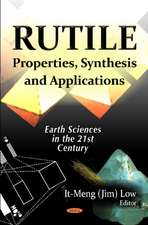Rutley’s Elements of Mineralogy
Autor C.D. Gribbleen Limba Engleză Paperback – 30 noi 1988
Preț: 643.00 lei
Preț vechi: 756.47 lei
-15% Nou
Puncte Express: 965
Preț estimativ în valută:
123.03€ • 129.15$ • 102.12£
123.03€ • 129.15$ • 102.12£
Carte tipărită la comandă
Livrare economică 10-24 aprilie
Preluare comenzi: 021 569.72.76
Specificații
ISBN-13: 9780045490110
ISBN-10: 0045490112
Pagini: 496
Ilustrații: 496 p.
Dimensiuni: 127 x 203 x 26 mm
Greutate: 0.49 kg
Ediția:27th ed. 1988
Editura: SPRINGER NETHERLANDS
Colecția Springer
Locul publicării:Dordrecht, Netherlands
ISBN-10: 0045490112
Pagini: 496
Ilustrații: 496 p.
Dimensiuni: 127 x 203 x 26 mm
Greutate: 0.49 kg
Ediția:27th ed. 1988
Editura: SPRINGER NETHERLANDS
Colecția Springer
Locul publicării:Dordrecht, Netherlands
Public țintă
ResearchCuprins
1 The chemistry of minerals.- 1.1 States of matter.- 1.2 Elements, compounds and mixtures.- 1.3 Atoms and molecules.- 1.4 Atomic number, valency and atomic weight.- 1.5 Atomic bonding.- 1.6 Ion size and ionic radii.- 1.7 Ionic potential and behaviour of ions in magma.- 1.8 Periodic classification of the elements.- 1.9 Oxides, acids and bases, and salts.- 1.10 Oxidation and reduction.- 1.11 The electrochemical series of metals.- 1.12 Chemical analysis.- 2 Physical properties of minerals.- 2.1 Introduction.- 2.2 Characters dependent upon light.- 2.3 Taste, odour and feel.- 2.4 State of aggregation.- 2.5 Specific gravity.- 2.6 Characters dependent upon heat.- 2.7 Characters dependent upon magnetism, electricity and radioactivity.- 3. The elements of crystallography.- 3.1 Introduction.- 3.2 The internal structure of minerals.- 3.3 The nature of the crystalline state.- 3.4 Stereographic projection.- 3.5 Description of crystals.- 3.6 The crystal systems.- 3.7 Crystal drawings.- 3.8 Simple uses of crystal stereograms.- 4 The optical properties of minerals.- 4.1 Introduction.- 4.2 The nature of light.- 4.3 Reflection.- 4.4 Refraction.- 4.5 The petrological microscope.- 4.6 Isotropic and anisotropic substances.- 4.7 Isotropic minerals.- 4.8 Uniaxial minerals.- 4.9 Biaxial minerals.- 4.10 Pleochroism.- 4.11 Thin sections of rocks and minerals.- 4.12 Systematic description of minerals under the petrological microscope.- 4.13 The microscopic investigation of ore minerals.- 4.14 Microchemical tests.- 4.15 X-ray diffraction studies of minerals.- 5 The occurrence of minerals.- 5.1 Introduction.- 5.2 Classification of rocks.- 5.3 Igneous rocks.- 5.4 Sedimentary rocks.- 5.5 Metamorphic rocks.- 5.6 Mineral deposits.- 5.7 Earth history.- 6 The classification of minerals.- 7 Economic grouping of minerals according to elements.- Ia Lithium, sodium and potassium.- Ib Copper, silver and gold.- IIa Calcium, strontium, barium and radium.- IIb Beryllium, magnesium, zinc, cadmium and mercury.- IIIb Boron and aluminium (gallium, indium).- IVa Titanium, zirconium, cerium and rare earth elements, and thorium.- IVb Carbon, silicon, tin and lead.- Va Vanadium, niobium and tantalum.- Vb Nitrogen, phosphorus, arsenic, antimony and bismuth.- VIa Chromium, molybdenum, tungsten and uranium.- VIb Sulphur, selenium and tellurium.- VIIa Manganese and rhenium.- Vllb Fluorine, chlorine, bromine and iodine.- Vllb Iron, cobalt and nickel.- VIIIb Ruthenium, rhodium, palladium, osmium, iridium and platinum.- 8 The non-silicate minerals.- 8.1 Native elements.- 8.2 Halides.- 8.3 Sulphides.- 8.4 Oxides.- 8.5 Carbonates.- 8.6 Nitrates.- 8.7 Borates.- 8.8 Sulphates.- 8.9 Chromates.- 8.10 Phosphates, arsenates and vanadates.- 8.11 Molybdates and tungstates.- 9 The silicate minerals.- 9.1 Crystal chemistry of silicate minerals.- 9.2 Nesosilicates.- 9.3 Sorosilicates.- 9.4 Cyclosilicates.- 9.5 Inosilicates (chain silicates).- 9.6 Phyllosilicates (sheet silicates).- 9.7 Tektosilicates (framework silicates).- Appendix A Analysis by the blowpipe.- A.1 The blowpipe.- A.2 The two types of flame.- A.3 Supports.- A.4 Fluxes.- A.5 Tube tests.- A.6 Reactions.- A.7 Tables of blowpipe analyses.- Appendix B Hydrocarbons.- B.1 Introduction.- B.2 Coals.- B.3 Bitumens.
Recenzii
...a must for all geologists at whatever level. Previous editions have been extensively used, and this new one will be no exception. The changes and additions have improved the book and brought it right up to date both in content and style, and it is sensibly priced for today's undergraduate and highly recommended. - British Geologist








